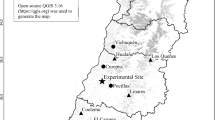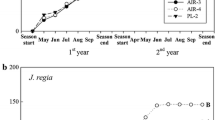Abstract
Cedrela odorata (Spanish cedar) is a valuable multi-purpose tree which Central American rural communities and farmers give priority to introducing in pastures and home gardens. In order to propose realistic methods for C. odorata production in local nurseries in the dry tropical region of Nicaragua, we studied: (a) the ability of locally collected C. odorata seeds to germinate, (b) seed response to storage under ambient conditions or under cold storage, (c) the effects of irradiance and watering during cultivation on seedling morphology and post-transplantation survival, and (d) the effects of competition from grasses on C. odorata seedlings transplanted to pastures. Seed germination ranged from 55 to 66% and remained constant after 6 months of storage under ambient conditions or cold storage. C. odorata seedling morphology was sensitive to irradiation and watering in the nursery growing period. Deep shade reduced seedling biomass and leafiness and increased specific leaf area and root-to-shoot ratio. Water shortage increased root mass ratio and root-to-shoot ratio and decreased leaf mass ratio. Post-transplantation success was favored by weeding, and was the highest for seedlings grown under deep shade and water restrictions.




Similar content being viewed by others
References
Becker P, Sharbini N, Yahya R (1999) Root architecture and root: shoot allocation of shrubs and saplings in two lowland tropical forests: implications for life-form composition. Biotropica 31:93–101. doi:10.1111/j.1744-7429.1999.tb00120.x
Beer J, Muschler R, Kass D, Somarriba E (1998) Shade management in coffee and cacao plantations. Agrofor Syst 38:139–164. doi:10.1023/A:1005956528316
Böhringer A, Ayuk ET, Katanga R, Ruvuga S (2003) Farmer nurseries as a catalyst for developing sustainable land use systems in southern Africa Part A: nursery productivity and organization. Agr Syst 77:187–201. doi:10.1016/S0308-521X(02)00185-3
Buitink J, Leprince O, Hemminga MA, Hoekstra FA (2000) Molecular mobility in the cytoplasm: an approach to describe and predict lifespan of dry germplasm. Proc Natl Acad Sci USA 97:2385–2390
Coomes D, Grubb PJ (2000) Impacts of root competition in forests and woodlands: a theoretical framework and review of experiments. Ecol Monogr 70:171–207. doi:10.1890/0012-9615(2000)070[0171:IORCIF]2.0.CO;2
Current D, Lutz E, Scherr SJ (1995) The costs and benefits of agroforestry to farmers. World Bank Res Obs 10:151–180. doi:10.1093/wbro/10.2.151
González-Rivas B, Tibagu M, Gerhardt K, Castro-Marín G, Odén PC (2006) Species composition, diversity and local uses of tropical dry deciduous and gallery forests in Nicaragua. Biodivers Conserv 15:1509–1527. doi:10.1007/s10531-005-2632-0
González-Rivas B, Tibagu M, Gerhardt K, Castro-Marín G, Odén PC (2009) Seed germination and seedling establishment of neotropical dry forest species in response to temperature and light conditions. J For Res 20:99–104. doi:10.1007/s11676-009-0018-y
Grijpma P, Gara RI (1970) Studies on the shootborer Hypsipyla grandella (Zeller): I. Host selection behavior. In: Grijpma P (ed.) Studies on the shootborer Hypsipyla grandella (Zeller) Lep., Pyralidae. Vol 1. Miscellaneous Publications No. 101. Inter-American Institute of Agricultural Sciences, San José
Griscom HP, Ashton PMS, Berlyn GP (2005) Seedling survival and growth of native tree species in pastures: implications for dry tropical forest rehabilitation in central Panama. For Ecol Manag 218:306–318. doi:10.1016/j.foreco.2005.08.026
Gyimah R, Nakao T (2007) Early growth and photosynthetic responses to light in seedlings of three tropical species differing in successional strategies. New For 33:217–236. doi:10.1007/s11056-006-9028-1
Huante P, Rincón E (1998) Responses to light changes in tropical deciduous woody seedlings with contrasting growth rates. Oecologia 113:53–66. doi:10.1007/s004420050353
Ibrahim M, Camargo JC (2001) Cómo aumentar la regeneración de árboles maderables en potreros? Agroforestería en las Américas 8:35–41. ftp://ftp.fao.org/docrep/nonfao/lead/x6354s/x6354s00.pdf. Accessed 07 Feb 2007
Joslin AH, Markewitz D, Morris LA, Oliveira FD, Figueiredo RO, Kato OR (2011) Five native tree species and manioc under slash-and-mulch agroforestry in the eastern Amazon of Brazil: plant growth and soil responses. Agrofor Syst 81:1–14. doi:10.1007/s10457-010-9356-1
Kitajima K (1994) Relative importance of photosynthetic traits and allocation patterns as correlated of seedling shade tolerance of 13 tropical trees. Oecologia 98:419–428. doi:10.1007/BF00324232
Kobe RK (1999) Light gradient partitioning among tropical tree species through differential seedling mortality and growth. Ecology 80:187–201. doi:10.1890/0012-9658(1999)080[0187:LGPATT]2.0.CO;2
Love B, Spaner D (2005) A survey of small-scale farmers using trees in pastures in Herrera province, Panama. J Sustain Forest 20:37–65. doi:10.1300/J091v20n03_03
Márquez J, Xotla U, González JE (2005) Estudio de la germinación y crecimiento inicial de plántulas de Cedrela odorata L. Foresta Veracruzana 7:45–52. http://redalyc.uaemex.mx/pdf/497/49770208.pdf. Accessed 07 Feb 2011
Méndez VE, Lok R, Somarriba E (2001) Interdisciplinary analysis of homegardens in Nicaragua: micro-zonation, plant use and socioeconomic importance. Agrofor Syst 51:85–96. doi:10.1023/A:1010622430223
Mercer DE (2004) Adoption of agroforestry innovations in the tropics: a review. Agrofor Syst 204411:311–328. doi:10.1023/B:AGFO.0000029007.85754.70
Mexal JG, Cuevas RA, Negreros-Castillo P, Paraguirre C (2002) Nursery production practices affect survival and growth of tropical hardwoods in Quintana Roo, Mexico. For Ecol Manag 168:125–133. doi:10.1016/S0378-1127(01)00735-6
Navarro C, Montagnini F, Hernández G (2004) Genetic variability of Cedrela odorata Linnaeus: results of early performance of provenances and families from Mesoamerica grown in association with coffee. For Ecol Manag 192:217–227. doi:10.1016/j.foreco.2004.01.037
Newman Y, Vendramini J, Blount A (2010) Bahiagrass (Paspalum notatum): overview and management. Florida Cooperative Extension Service, University of Florida. SS-AGR-332. http://edis.ifas.ufl.edu/pdffiles/AG/AG34200.pdf. Accessed 1 March 2011
Newton AC, Baker P, Ramnarin S, Mesrn JF, Leakey RRB (1993) The mahogany shoot borer: prospects for control. For Ecol Manag 57:301–328. doi:10.1016/0378-1127(93)90179-Q
Pennington TD, Styles BT, Taylor DAH (1981) Meliaceae with accounts of Swietenioideae and Chemotaxonomy. Flora Neotropica, Monograph No. 28. The New York Botanical Garden, New York 470 pp
Poorter L (1999) Growth responses of 15 rain-forest tree species to a light gradient: the relative importance of morphological and physiological traits. Funct Ecol 13:396–410. doi:10.1046/j.1365-2435.1999.00332.x
Poorter L, Hayashida-Oliver Y (2000) Effects of seasonal drought on gap and understory seedlings in a Bolivian moist forest. J Trop Ecol 16:481–498. doi:10.1007/s00468-004-0393-0
Ricker M, Siebe C, Sánchez S, Shimada K, Larson BC, Martínez-Ramos M, Montagnini F (2000) Optimizing seedling management: Pouteria sapota, Diospyros digyna and Cedrela odorata in a Mexican rainforest. For Ecol Manag 139:63–77. doi:10.1016/S0378-1127(99)00335-7
Royal Botanic Gardens (2008) Kew. Seed Information Database (SID). Version 7.1. Royal Botanic Gardens Kew. http://data.kew.org/sid/. Accessed 4 March 2011
Sacandé M, Golovina EA, van Aelst AC, Hoekstra FA (2001) Viability loss of neem (Azadirachta indica) seeds associated with membrane phase behavior. J Exp Bot 52:919–931. doi:10.1093/jexbot/52.358.919
SAS (1999) SAS OnlineDoc®, Version 8. SAS Institute Inc, Cary, NC, USA
Sautu A, Baskin JM, Baskin CC, Condit R (2006) Studies on the seed biology of 100 native species of threes in a seasonal moist tropical forest, Panama, Central America. For Ecol Manag 234:245–263. doi:10.1016/j.foreco.2006.07.006
Ticktin T, Dalle SP (2005) Medicinal plant use in the practice of midwifery in rural Honduras. J Ethnopharmacol 96:233–248. doi:10.1016/j.jep.2004.09.015
Vázquez-Yanes C, Orozco-Segovia A (1993) Patterns of seed longevity and germination in the tropical rainforest. Annu Rev Ecol Syst 24:69–87. http://www.jstor.org/stable/pdfplus/2097173.pdf
Walker BH, Ludwig D, Holling CS, Peterman RM (1981) Stability of semi-arid savanna grazing systems. J Ecol 69: 473–498. http://www.jstor.org/stable/2259679
Webb MJ, Weddell P, Hambleton A, Robson K (2000) Growth response of four tropical plantation timber species to increasing phosphorus supply and assessment of phosphorus requirements using foliar analysis. New For 20:21–193. doi:10.1023/A:1006756105284
Acknowledgments
This work was funded by the Catalan Agency for Development and Cooperation (ACCD) and is part of the research project “Social multicriteria evaluation for the sustainable management and conservation of the Miraflor-Moropotente Protected Terrestrial Landscape”. We are particularly thankful to Mr. Andrés Rodriguez, who kindly offered his farm for the experiments.
Author information
Authors and Affiliations
Corresponding author
Rights and permissions
About this article
Cite this article
Andrés, P., Salgado, C. & Espelta, J.M. Optimizing nursery and plantation methods to grow Cedrela odorata seedlings in tropical dry agroecosystems. Agroforest Syst 83, 225–234 (2011). https://doi.org/10.1007/s10457-011-9404-5
Received:
Accepted:
Published:
Issue Date:
DOI: https://doi.org/10.1007/s10457-011-9404-5




